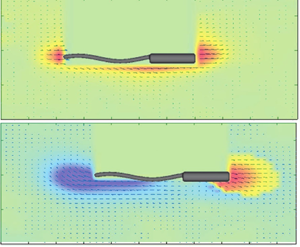Published online by Cambridge University Press: 16 May 2022

We investigate the effects of helical swimmer shape (i.e. helical pitch angle and tail thickness) on swimming dynamics in a constant viscosity viscoelastic (Boger) fluid via a combination of particle tracking velocimetry, particle image velocimetry and three-dimensional simulations of the finitely extensible nonlinear elastic model with Peterlin approximation (FENE-P). The 3D-printed helical swimmer is actuated in a magnetic field using a custom-built rotating Helmholtz coil. Our results indicate that increasing the swimmer tail thickness and pitch angle enhances the normalized swimming speed (i.e. ratio of swimming speed in the Boger fluid to that of the Newtonian fluid). Strikingly, unlike the Newtonian fluid, the viscoelastic flow around the swimmer is characterized by formation of a front–back flow asymmetry that is characterized by a strong negative wake downstream of the swimmer's body. Evidently, the strength of the negative wake is inversely proportional to the normalized swimming speed. Three-dimensional simulations of the swimmer with the FENE-P model with conditions that match those of experiments, confirm formation of a similar front–back flow asymmetry around the swimmer. Finally, by developing an approximate force balance in the streamwise direction, we show that the contribution of polymer stresses in the interior region of the helix may provide a mechanism for swimming enhancement or diminution in the viscoelastic fluid.